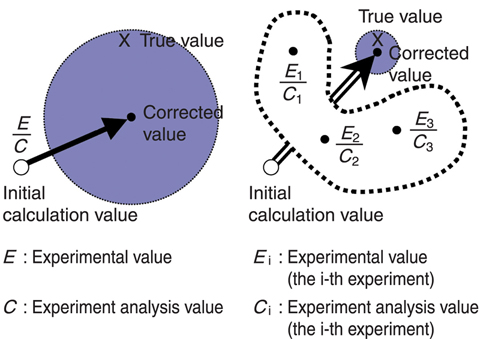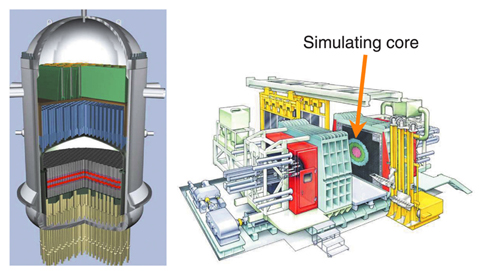
| (a) Conventional method | (b) Extended bias factor method |
Fig.7-3 Characteristics of extended bias factor method

| (c) Innovative light water reactor (FLWR) |
(d) Fast critical assembly (FCA) |
Fig.7-4 Application of FCA critical experiments to a new type reactor core design
To develop a new type reactor, accurate prediction of core performance is required. This is done with calculation codes to analyze neutron behavior based on evaluated nuclear data. With a full-scale mock-up experiment very similar to the planned core, the prediction accuracy can be validated by a comparison between the analysis value of the simulation model and the experimental value. However, comparisons are often limited to experiments with existing experimental facilities. Therefore, they may not properly simulate the planned core and it is difficult to validate the prediction accuracy. However, a full-scale mock-up experiment with new experimental facilities is costly. Thus, it is very difficult to conduct full-scale mock-up experiments.
To overcome such difficulties, we created a new method named the extended bias factor method. The method can evaluate the prediction uncertainty without a full-scale mock-up experiment, based on an original concept: utilize experimental results from a number of existing facilities in place of a mock-up facility. Taking the variance of experimental results into consideration, it utilizes the covariances arising from the nuclear data and the analysis method in the design values and the experiment analysis values of the planned core and each of the utilized existing cores which are caused by cross section and analysis method errors, and maximizes the correlation between the planned core and the experimental results. By this method, the prediction accuracy can be properly evaluated and improved (Fig.7-3).
To apply the extended bias factor method to a real group of experimental results, we developed new methods to practically evaluate covariance between experimental values and between experiment analysis values and constructed a system to evaluate covariance between different experimental results and between different cores. Based on this system, we applied this method to a new type reactor core design using the experimental results systematically measured with several simulating cores constructed in an existing facility, Fast Critical Assembly (FCA). The application results demonstrated that the method is valid for the evaluation and improvement of the prediction accuracy of core performance of the target core (Fig.7-4).
By evaluating sources of error in prediction with the extended bias factor method, we can identify necessary new critical experiments, and the experiments and the analysis method by which uncertainties can be reduced. The present R&D results can be utilized to contribute to planning of effective R&D, saving time and cost for development of the new type reactor.
The present R&D was honored with an award for distinguished technology by the Atomic Energy Society of Japan in March, 2009.
<Previous: 7 Nuclear Science and Engineering Research | Next: 7-2 >